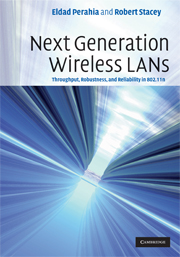Book contents
- Frontmatter
- Contents
- Foreword by Dr. Andrew Myles
- Preface
- List of abbreviations
- 1 Introduction
- Part I Physical layer
- Part II Medium access control layer
- 7 Medium access control
- 8 MAC throughput enhancements
- 9 Advanced channel access techniques
- 10 Interoperability and coexistence
- 11 MAC frame formats
- Part III Transmit beamforming
- Index
- References
9 - Advanced channel access techniques
from Part II - Medium access control layer
Published online by Cambridge University Press: 04 December 2009
- Frontmatter
- Contents
- Foreword by Dr. Andrew Myles
- Preface
- List of abbreviations
- 1 Introduction
- Part I Physical layer
- Part II Medium access control layer
- 7 Medium access control
- 8 MAC throughput enhancements
- 9 Advanced channel access techniques
- 10 Interoperability and coexistence
- 11 MAC frame formats
- Part III Transmit beamforming
- Index
- References
Summary
This chapter introduces some of the advanced channel access techniques in the 802.11 standard. In addition to, and built upon, the distributed channel access techniques described in Chapter 7, the 802.11 standard includes two centrally coordinated channel access techniques. The PCF was introduced in the original 802.11 specification and HCCA was introduced in the 802.11e amendment to support parameterized QoS and to fix some of the deficiencies in the PCF. The chapter then introduces new channel access techniques in the 802.11n amendment.
A very simple technique called the reverse direction protocol was introduced with one bit of additional signaling and some simple changes to the rules for operating a TXOP. This technique is particularly effective under EDCA for improving throughput for certain traffic patterns.
During the development of the 802.11n amendment, a strong interest emerged among many participants for improving the power efficiency of the MAC protocol. While outside the scope of the 802.11n PAR this resulted in the power-save multi-poll (PSMP).
PCF
Infrastructure network configurations may optionally include the point coordination function (PCF). With PCF, the point coordinator (PC), which resides in the AP, establishes a periodic contention free period (CFP) during which contention free access to the wireless medium is coordinated by the PC. During the CFP the NAV of all nearby stations is set to the maximum expected duration of the CFP. In addition, all frame transfers during the CFP use an inter-frame spacing that is less than that used to access the medium under DCF, preventing stations from gaining access to the medium using contention-based mechanisms.
Information
- Type
- Chapter
- Information
- Next Generation Wireless LANsThroughput, Robustness, and Reliability in 802.11n, pp. 225 - 237Publisher: Cambridge University PressPrint publication year: 2008
